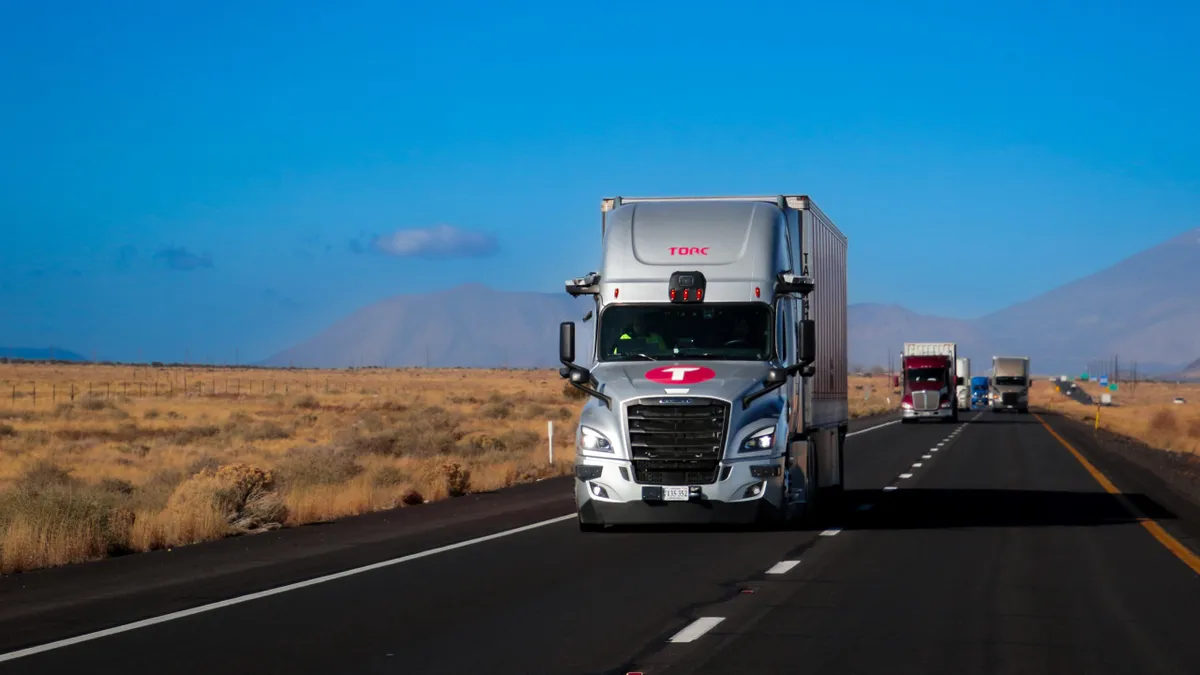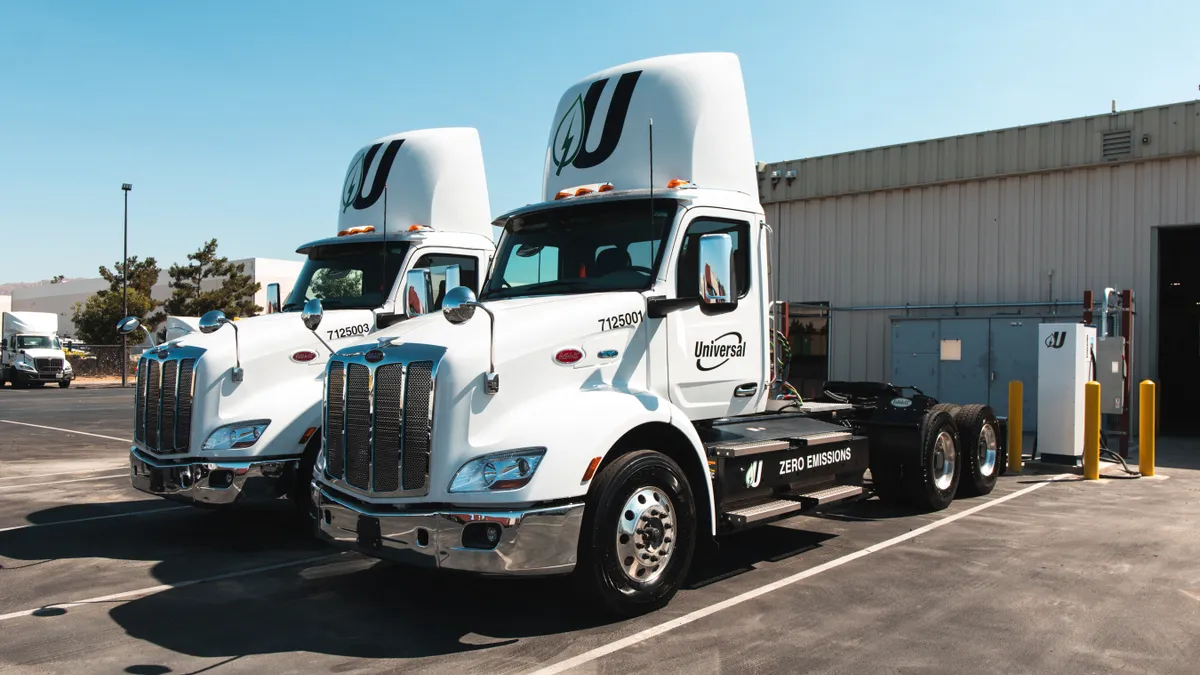Torc Robotics aims to be operating its autonomous trucks in multiple locations with various equipment versions, a company executive told Trucking Dive in an interview.

Walter Grigg, the company's head of industry partnerships, sat down with Trucking Dive during the Manifest Vegas 2024 conference in early February. During the chat, Grigg highlighted a refined testing route, explained why testing has grown in New Mexico, and shared advice on how to make sense of the ever-evolving autonomous trucking space.
Read the Q&A below for more insights about the Daimler-owned autonomous trucking firm's strategy and operations.
Editor’s note: This interview has been edited for clarity and brevity.
TRUCKING DIVE: How's it going? Can you reveal who you're partnering with currently and who is testing your technology?
WALTER GRIGG: We have a couple that are publicly announced: Schneider is an incredible and close partner; C.R. England; and then we work with a lot of others that aren't at a public stage yet. But most folks in the industry that are looking at this technology are already involved.
We also have a large advisory council — which consists of the majority of the large players in the industry — giving us guidance on how they see this technology being applied from their perspective. We also provide them feedback on how we're doing, so you get that exchange.
What states are you currently testing in?
Torc is headquartered in Blacksburg, Virginia, so we utilize small sections of I-81 for some advanced development, but primarily our largest on-road testing facility is in Albuquerque, New Mexico, and we leverage the I-40 corridor.
Albuquerque is an incredible training environment. You've got the big I — the I-40, I-25 interchange — as well as mountainous environments right around Albuquerque. You have dense city traffic. You have long straight runs. So we're routinely running between points west of Albuquerque and points east.
Is there a specific trade lane that you're operating in?
It has been more about the larger scale development of the product. We're just now transitioning into a more refined, in your terms, trade lane for our minimum viable product, and that is not ready for announcement yet. But it will be soon.
Okay. Well, we'll look forward to that announcement when it comes.
It's helpful to have a development timeline, right? What timeline are you looking at for — I don't want to say fully driverless because people confuse what that means all the time —
There's a lot packed into that, right?
So, Martin Daum, the CEO of Daimler Truck — which we're a subsidiary of — at this past capital days, announced a target of 2027 to be getting commercial scaling.
Got it. And you said you're currently testing a minimum viable product. Can you give me an idea of what that looks like?
Yeah. For a product to be minimum viable, it has to be inherently safe. If it's not safe, it's not a product, and there's no reason for it to be on the road.
It has to be economically viable: It has to solve a problem that needs to be solved for the industry, in a particular operating lane. And it needs to be commercially scalable: We need to be able to service it and maintain it.
Interesting. When you look at industry partnerships, sometimes tech companies tend to focus on a type of customer or vertical. What's the type of ideal partner that you tend to look for?
It's a spectrum.
We're developing the solution to be able to cover, effectively, Class 8, while targeting van/reefer-based early on. So, looking at any of the potential customers in that type of equipment type or asset class, and that would have freight viable in those MVP lanes. Then, moving out to what we refer to as "phase one lanes," which speaks to expansion.
So that's kind of who we're looking for early on, but that does not limit us. We've got a lot of interest and a lot of conversations happening in other sub-segments of the industry. But we are primarily targeting Class 8, over-the-road, and what we call hub-to-hub in the truckload space.
That just reminded me: Earlier you mentioned there's an ideal testing environment, and Albuquerque provides that. What makes it an ideal testing environment?
I don't want to try to leverage that we have found the best place and no one else has. It becomes an ideal environment because we're able to maximize the learning opportunities in an asset-utilization-positive way.
We can get tons of information on things like surface streets, because Albuquerque has a lot of different varieties of that. We get the ability to have a myriad of merging on-and-off lane changes. We get dense inner city traffic. Very close to town, we actually have a significant hill climb, a significant grade, and therefore we have downgrade as well. So we can climb and we can descend just over the hills. We can run east you know, all the way out to Texas – a straight and narrow path, right? And that has its own environment. You could head west on I-40, find yourself all the way up to the Continental Divide.
There's all kinds of stuff going over there. It is ideal in that we are able to maximize the utility of our physical assets and our engineering assets and resources in a very small space. So basically, we can learn fast.
What's the biggest thing that you're testing for right now? Or the biggest problem that you're trying to solve?
The initial use case, like we said, is that hub-to-hub, over the road. Maximizing the time and distance on Interstate-based driving. So that's where the early utility of this technology will be: In that training environment. But we ultimately have to handle all reasonable scenarios that might occur inside that environment.
So, we're in February. By the end of 2024, what do you hope to have achieved?
We have very significant internal timelines and objectives. So, significant improvements.
We're working right now on ultimately, fielding early-production-intent vehicles. So, by the end of the year, I think you'll see us operating in different locations. And you'll see different equipment versionings that are all working toward commercialization of the product.
There are certainly states in the AV landscape that others have pointed to as places to start testing or operating in. Do you have a list like that?
I can tell you who has been very helpful, where we have been testing. There's a couple of factors that ultimately drive where Class 8 over-the-road autonomy will commercialize.
The first, actually, is the design environment. The operational design domain, as the industry refers to it, speaks to things like weather, roads, structures, or geometries and so on.
At the same time, you look at which states are either permissive or very inviting. And what we have found is New Mexico, Texas, Arizona, have all been extremely helpful. So actually, we have our on-road testing headquarters there in Albuquerque, New Mexico. The state has been extremely helpful, very inviting. They're clearly promoting innovation. There's no question.
Texas, very similar. They're inviting. They incentivize innovation done safely and responsibly. In Arizona, we actually did some testing early on in the state. It's all very inviting of innovation, all very inviting of technology, so long as it's done in a safe, responsible way.
I always like to end with this: Is there anything else you want to say to a trucking executive who may read your comments?
I definitely want you to take away that our adherence and conformance to safety is full stop.
If we are not testing in a safe way and protecting the public around us, we're done. There is no more testing. And we respect that. We see testing on public roads as a sincere privilege, and we respect that. And therefore we have protocols, procedures, training and the people that are in the vehicles, multiple layers of oversight, to make sure that's happening.
The other is advice to a lot of the transportation industry executives: Start to get a feel for who the players are. Just start to pick up the names of who's out there as the industry evolves. It's a who, it's where, it's a when, and it's a how, right?
We saw last year there were entrances and exits. It's an early technology in the grand scheme of things, so don't get too caught up in every name. Just kind of understand who the big players are, where the deep partnerships exist — for example, our deep partnership with Daimler, the market share leader in Class 8 over-the-road.
So understand those levels, and then watch the industry as it evolves.





















